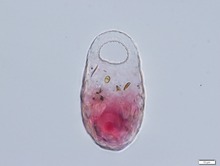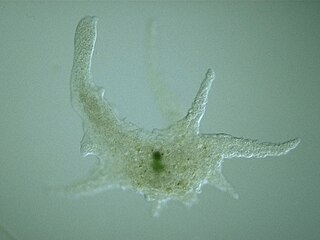
Amoebozoa is a major taxonomic group containing about 2,400 described species of amoeboid protists, often possessing blunt, fingerlike, lobose pseudopods and tubular mitochondrial cristae. In traditional classification schemes, Amoebozoa is usually ranked as a phylum within either the kingdom Protista or the kingdom Protozoa. In the classification favored by the International Society of Protistologists, it is retained as an unranked "supergroup" within Eukaryota. Molecular genetic analysis supports Amoebozoa as a monophyletic clade. Modern studies of eukaryotic phylogenetic trees identify it as the sister group to Opisthokonta, another major clade which contains both fungi and animals as well as several other clades comprising some 300 species of unicellular eukaryotes. Amoebozoa and Opisthokonta are sometimes grouped together in a high-level taxon, variously named Unikonta, Amorphea or Opimoda.
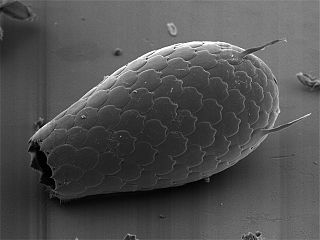
The euglyphids are a prominent group of filose amoebae that produce shells or tests that in most described species is reinforced by siliceous scales, plates, and sometimes spines, but this reinforcement is absent in other species. These elements are created within the cell and then assembled on its surface in a more or less regular arrangement, giving the test a textured appearance. There is a single opening for the long slender pseudopods, which capture food and pull the cell across the substrate.

Difflugia is the largest genus of Arcellinida, one of several groups of Tubulinea within the eukaryote supergroup Amoebozoa. Arcellinida species produce shells or tests from mineral particles or biogenic elements and are thus commonly referred to as testate amoebae or shelled amoebae. Difflugia are particularly common in marshes and other freshwater habitats.

The Tubulinea are a major grouping of Amoebozoa, including most of the more familiar amoebae genera like Amoeba, Arcella, Difflugia and Hartmannella.

Monadofilosa is a grouping of Cercozoa. These organisms are single-celled amoeboid protists.

Arcellinid testate amoebae or Arcellinida, Arcellacean or lobose testate amoebae are single-celled protists partially enclosed in a simple test (shell).
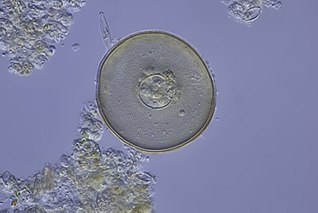
Arcella is a genus of testate amoebae in the order Arcellinida, usually found in freshwaters and mosses, and rarely in soils. A key characteristic of Arcella is the circular test with a hole on its center from where finger-like pseudopods emerge. It is one of the largest testacean genera.

Testate amoebae are a polyphyletic group of unicellular amoeboid protists, which differ from naked amoebae in the presence of a test that partially encloses the cell, with an aperture from which the pseudopodia emerge, that provides the amoeba with shelter from predators and environmental conditions.
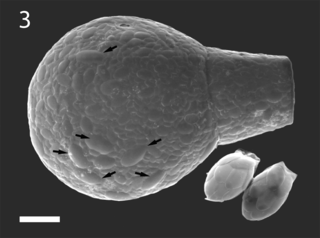
Apodera is a genus of amoeboid protists belonging to the family Hyalospheniidae, a group of shelled amoebae. Their shells, or tests, are lageniform with a clear constriction that separates the neck from the body.

Cryptodifflugia is a genus of arcellinid testate amoebae. It contains all the species previously grouped as the genus Difflugiella, which is now a synonym of Cryptodifflugia.
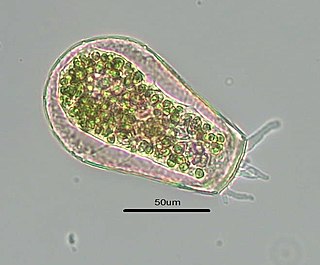
Hyalospheniidae is a family of arcellinid testate amoebae and the sole family of the infraorder Hyalospheniformes. Commonly referred to as "hyalospheniids", these lobose amoebae are characterized by their ability to generate a shell composed of either organic matter or siliceous particles that may be recycled from euglyphid amoebae. They inhabit soil or freshwater habitats, and are abundant on Sphagnum mosses.
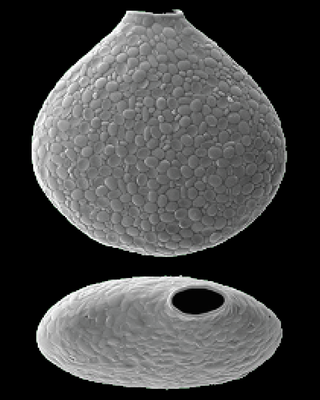
Nebela is a diverse genus of testate amoebae of cosmopolitan distribution, belonging to the family Hyalospheniidae. They are "prey agglutinated" or "kleptosquamic" organisms, meaning they take the inorganic plates from their prey to construct their test.

Certesella is a genus of testate amoebae belonging to the family Hyalospheniidae. It is characterized by a test that presents two symmetrical holes near the opening, and by the presence of internal teeth within the test. It contains four species previously assigned to Nebela, as well as one species discovered in 2021.
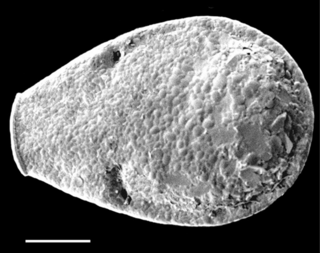
Porosia is a genus of arcellinid testate amoebae belonging to the family Hyalospheniidae. Described in 1942, it used to be a monotypic genus with the sole species P. bigibbosa. However a second species, P. paracarinata, was discovered in 2015.

Cryptodifflugiidae is a family of arcellinid testate amoebae.
Leptogromia operculata is a species of testate amoeba which has three flexible 'membranes' which can be opened or closed, and has a large number of filopodia which L. operculata uses to move around and to catch prey.

Meisterfeldia is a genus of arcellinid testate amoebae erected in 2016 that unites several new species as well as old species previously found in the genus Cryptodifflugia. Five of the newly described species were first found and isolated from subarctic tundra soil surrounding a river near Chokurdakh, Russia, while the last one, described in 2021, was recovered from tree hollows in Moscow.

Cryptodifflugia leachi is an aquatic species of testate amoebae discovered in 2006 in Canada, living in bottom sediment from wetlands at the base of the Niagara Escarpment.

Planocarina is a genus of arcellinid testate amoebae belonging to the family Hyalospheniidae. It was created in 2016 to agglutinate a clade of species that were previously assigned to the paraphyletic genus Nebela. All species of Planocarina have a compressed keel surrounding the posterior part of their shell. It is the sister group of Alabasta.

Alabasta is a genus of arcellinid testate amoebae belonging to the family Hyalospheniidae. It contains species with an elongated test and a strongly curved "pseudostome" with a flare and a notch in narrow view. These species previously belonged to the genus Nebela, but were later found to be a distinct monophyletic group different from Nebela. It is the sister group to Planocarina.
